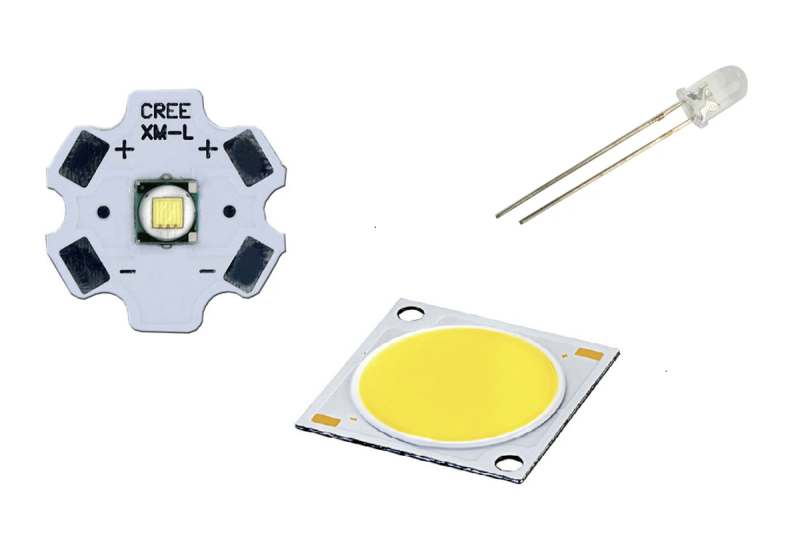[ez-toc]
We come across the word LED almost every day. What is an LED? LED stands for Light Emitting Diode, which can be translated as “light-emitting diode”. LED is a form of diode that has been developed to produce light.
You’ll most often see these three letters when you’re buying a TV or a new phone. Nowadays, all display terminals are equipped with LED backlighting and LED lights illuminate our homes.
The principle of LEDs was born as early as 1907. We have written an article on the subject:
“Electroluminescence, the principle behind LEDs, was first discovered by Henry Joseph Round in 1907. But it wasn’t until 1962 that engineer Nick Holonyak used the science to create LEDs that produce visible light as we know them..” – History of LEDs, a brief textbook
How does an LED light work?
Initially, the LED is acting like a PN diode. P=Positive (+) and N=Negative (-). It works on the same principle, i.e. it carries current in one direction only and no current can flow in the other direction. Why is this needed? If the electrons move in one direction, they form a current, which becomes the source of light in the reaction.
For the LED to work, it needs to be powered. That is, a voltage is applied to the P-pin. When the holes on the P side meet the electrons on the N side at the junction of the diode, energy is released and these photons produce light.
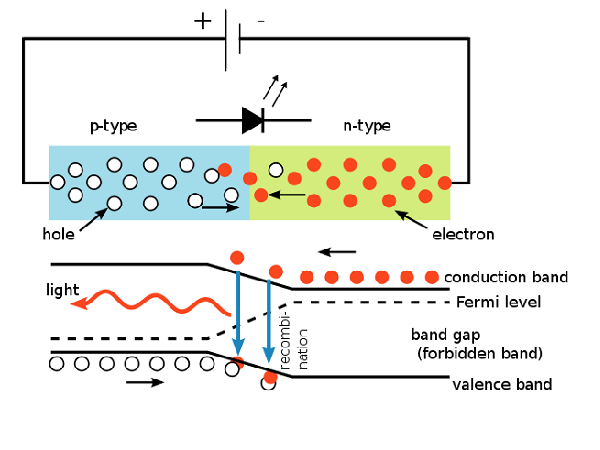
How does an LED differ from a traditional diode?
Now more about the LED, what is an LED, and how does it differ from a PN-DIOD? Not terribly much. Inside is an alloy semiconductor. The emission spectrum (light colour) depends on the degree of mixing and the material from which the semiconductor is made.
The biggest difference, of course, is in the design. So a traditional LED has a special hemispherical protection (applies to all LED types), which protects it from shocks and other external mechanical influences. Research has shown that it is the P side that releases the light, so in LED circuits the P side is as close to the surface as possible and as thin as possible to make the light as visible as possible.
For this reason, the body on top of the LED circuit is often made of epoxy resin or other transparent material that can be used to direct the photons in the desired direction.
Why does an LED need a Front resistor?
In order for an LED to burn at the appropriate voltage, it is usually necessary to install a front resistor . The nominal current required by the LED can be anything from 20mA to 5A, depending on the power of the LED.
The appropriate front resistance is calculated as follows: voltage – LED required voltage = front resistance voltage
The value of the front resistance (OHMI) is obtained by dividing the voltage (V) by the current (mA) required by the LED.
For example, if you have a 24V voltage and want to install a 19V threshold voltage COB LED with a current requirement of 350mA, you need the following calculation:
Residual voltage = 24V – 19V = 5V
Front resistance = 5V / 350mA = 5V / 0.014A = 357 Ohms
357 Ohm front resistance required
What are the advantages of LED light?
One of the most important features of LEDs is their high efficiency. The fact is that a traditional incandescent bulb emits a lot of heat during use, while an LED, on the contrary, stays quite cold. All this is because it produces most of the light in the spectrum visible to humans and does not waste energy on unnecessary wavelengths. The efficiency of an incandescent lamp is only 5%, while the efficiency of an LED lamp can be 90%. In addition, LED circuits are much smaller in size, so they can be placed anywhere and in any way.
What colours can LEDs produce?
To adjust the colour and intensity of the light, you need to choose the appropriate semiconductor material. The semiconductor used in the mixture is crucial, as its reaction with the electrodes affects the colour of the light. However, LEDs do not necessarily emit all colours, and it is possible to achieve an accurate spectrum.
The most common colours are red, yellow, green and orange. This is all because they are easier to produce and, accordingly, many times cheaper than the blue and white ones that appeared in the 1990s.
In this table I have listed the semiconductor materials used to achieve a particular colour of light:
| Wavelength (NM) | Colour | VF @ 20MA | Material from |
| < 400 | Ultraviolet | 3.1 – 4.4 | Aluminium nitride (AlN) |
| Aluminium gallium nitride (AlGaN) | |||
| Aluminium gallium indium nitride (AlGaInN) | |||
| 400 – 450 | Purple | 2.8 – 4.0 | Indium gallium nitride (InGaN) |
| 450 – 500 | Blue | 2.5 – 3.7 | Indium gallium nitride (InGaN) |
| Silicon carbide (SiC) | |||
| 500 – 570 | Green | 1.9 – 4.0 | Gallium phosphide (GaP) |
| Aluminium gallium indium phosphide (AlGaInP) | |||
| Aluminium gallium phosphide (AlGaP) | |||
| 570 – 590 | Yellow | 2.1 – 2.2 | Gallium arsenide phosphide (GaAsP) |
| Aluminium gallium indium phosphide (AlGaInP) | |||
| Gallium phosphide (GaP) | |||
| 590 – 610 | Orange | 2.0 – 2.1 | Gallium arsenide phosphide (GaAsP) |
| Aluminium gallium indium phosphide (AlGaUInP) | |||
| Gallium phosphide (GaP) | |||
| 610 – 760 | Red | 1.6 – 2.0 | Aluminium gallium arsenide (AlGaAs) |
| Gallium arsenide phosphide (GaAsP) | |||
| Aluminium gallium indium phosphide (AlGaInP) | |||
| Gallium phosphide (GaP) | |||
| > 760 | Infrared | < 1.9 | Gallium arsenide (GaAs) |
| Aluminium gallium arsenide (AlGaAs) |
The table shows that the same semiconductor material is suitable for several different colours and the manufacturer decides which material to use. The key factor is availability and price, which vary.
How are LEDs built?
Now that we know how the LED works, let’s talk a bit more about how it works in parts. Each LED consists of the following components:
- cathode
- anodi
- Semiconductor circuit
- reflector
- diffuser
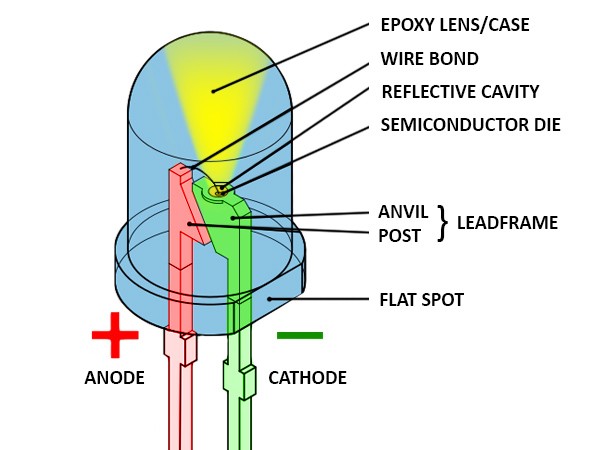
Each of these components is important for the functioning of LED light. The main parts inside the LED are the cathode and the anode. What do these parts do in an LED?
Electrons go from the cathode (-) to the anode (+) when a voltage is applied to the device. As a result, electrons meet at the PN junction and occupy the vacant spaces (holes) there. As a result, electrons move to a new energy level and photons are released. As I wrote earlier, photons are directed upwards by a reflector and a diffuser (for example, an epoxy resin).
How do different LED technologies differ?
If we talk about the main types of LED lights, they are of course LED lights (general lighting) and signage LED lights (usually for electronics devices)
LEDs can also be differentiated into different technologies according to the manufacturing process:
DIP-LED
The first commercial LED type. These are fairly simple and not very effective indicator lights. But they are quite cheap. They have a cylindrical lens, usually quite large compared to the LED circuit itself.
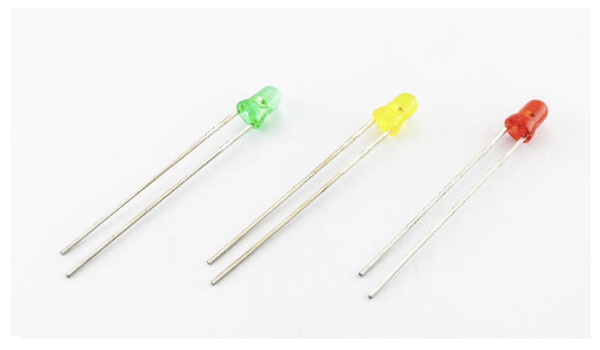
SMD LED
SMD LEDs were invented next. Traditional led lights are surface mounted and SMD provided a solution. They are much flatter and are only used for surface mounting. Installation is always against a heat-conducting material. SMD is the most common form of LED used in lighting (2023) and SMD development is far from over.
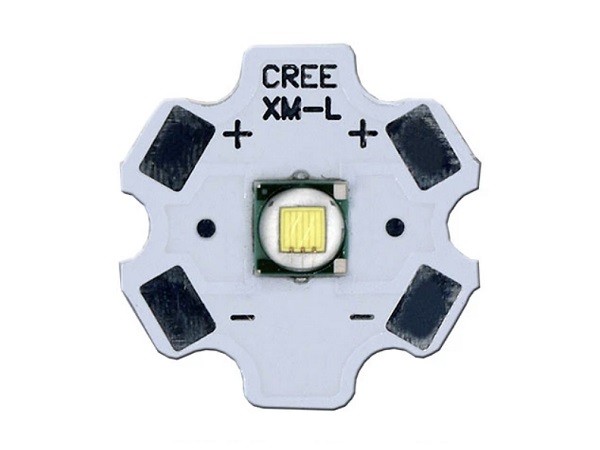
COB LED
Now the latest LED lights incorporate an LED circuit with COB (Clip On Board) technology. As the name implies, the LED, or rather several LEDs, are mounted directly on the base plate. They are very small. In addition to their small dimensions, they have the advantage of being very uniformly illuminated and well protected against oxidation (phosphor layer).
Thanks to these advantages, they were used, for example, in the automotive industry to create headlights. Since then they have become more common in led down lights and led strip lights.
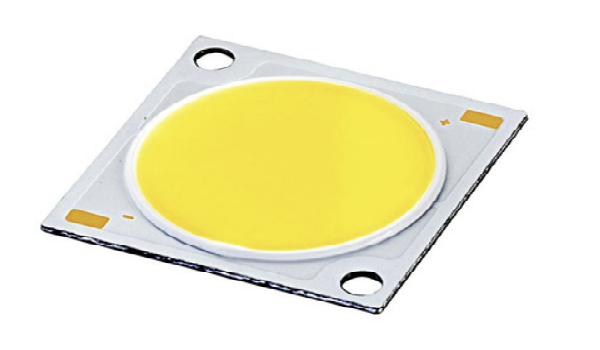
FILAMENT LED
Another new way of manufacturing LED circuits is filament (wire). The LED circuit in question spreads the light in all directions. Its main advantage is its appearance, as it looks like filament, as in incandescent lamps. This is why filament LEDs are mainly seen in LED bulbs.
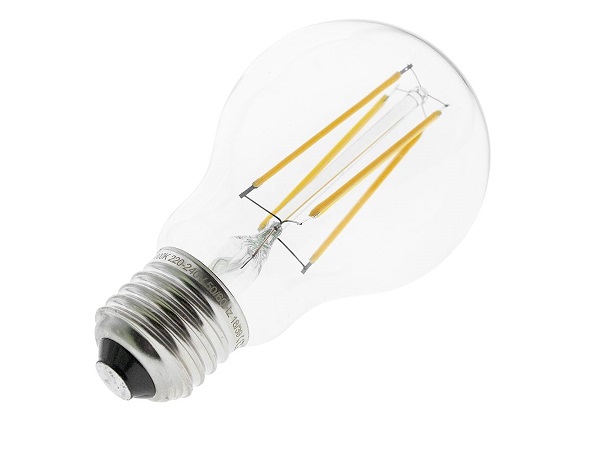
FIlament LED bulb
Here we answer the frequently asked question “what is an LED?”
Here are some other things to read:
Read also our product FAQs here: https://ledstore.fi/faq
LED technology in LED lights: why LED lights are the best solution for home lighting
Read the claims where we discuss the dangers of LEDs: what is the basis of the dangers of LEDs
Read more common questions: frequently asked questions about LEDs
We have also written about the quality of light: what is colour rendering?
*1 Source: https://upload.wikimedia.org/wikipedia/commons/thumb/d/d7/PnJunction-LED-E.svg/640px-PnJunction-LED-E.svg.png
*2 Source: https://www.electronics-notes.com/articles/electronic_components/diode/light-emitting-diode-led-technology-how-does-led-work.php
*3 Source: https://en.wikipedia.org/wiki/LED_circuit

